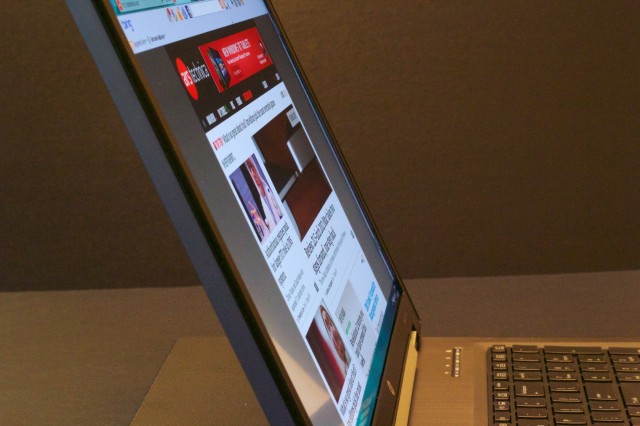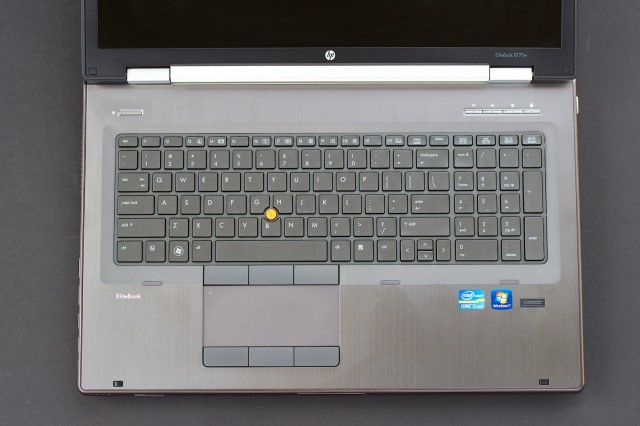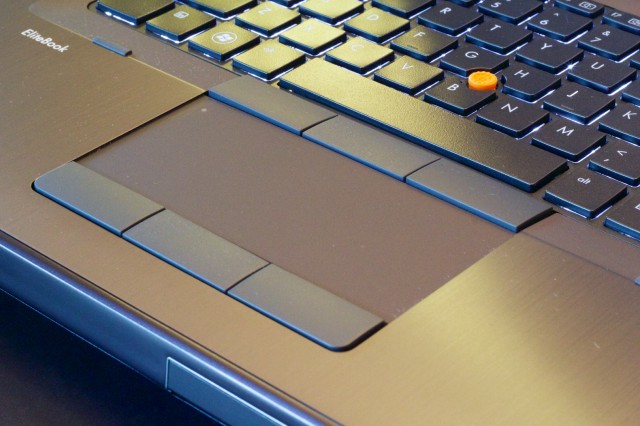When HP offered to send me a workstation-class 17-inch laptop to review, I thought it would be fun—who wouldn't want to play with a loaded-to-the-gills lapzilla? I told them to give me a maxed-out model and I'd put it through its paces. When the laptop actually arrived, though, I realized that I'd gotten far more hardware than I'd expected to receive.

| Specs at a glance: HP 8770w | |
|---|---|
| Screen | 1920×1080 17.3-inch "DreamColor" IPS, 127 PPI |
| OS | Windows 7 Professional 64-bit |
| CPU | 2.7GHz Intel Core i7-3820QM (Turbo Boost 3.7GHz) |
| RAM | 16GB 1600MHz DDR3 (upgradeable to 32GB) |
| GPU | Nvidia Quadro K5000M with 4GB DDR5 VRAM |
| Storage | 256GB SATA III SSD (Micron C400) |
| Networking | Intel Centrino 802.11n, Bluetooth 4.0, gigabit Ethernet |
| Ports | 1x VGA, 1x DisplayPort, 1x RJ-45 (Ethernet), 1x RJ-11 (modem), 1x IEEE 1394a, 2x USB 3.0, 2x USB 2.0, 1x eSATA/USB 2.0 combo, stereo mic in, stereo headphone/line out, docking connector |
| Battery | 8-cell 83Whr Li-ion |
| Size | 1.47 (at front)/1.68 (at rear) x 16.4 x 10.7 inches, 37.4 mm (at front)/42.7 mm (at rear) x 416.5 mm x 272.7 mm |
| Weight | 7.69 lb/3.6 kg |
| Starting price | $2658 (base 17" model starts at $1649) |
| Price as configured | $6435 (includes upgraded CPU, GPU, display, RAM, and storage) |
The Hewlett-Packard EliteBook 8000 series encompasses three models: the 14-inch 8470w, which is designed to be a travel-friendly entry-level mobile workstation; the 15-inch 8570w, a slightly larger laptop with more powerful pro-level features; and the hefty 8770w, which HP positions as a potential replacement for even a high-end desktop workstation. The model HP sent me was the 17-inch 8770w, packed with upgrades. When I popped over to the HP Web store and built an 8770w configuration to match the one sitting on my desk, my eyes bugged out a bit.
HP had sent me a $6,400 monster. This wasn't just more laptop than most folks need, it's also more laptop than most folks even have the ability to purchase. However, this isn't anywhere near a laptop for "most folks"—there's a very specific subset of users who require the high-dollar components packed into this 17-inch frame.
Who is this thing for?
If you have to ask, it's probably not for you. Even in the crazy configuration I received, a laptop like this is inherently a box of compromises: the extreme power means limited battery life, and the mobile components required to fit within the thermal design specs mean that it's not as fast as a similarly crazy desktop.
Still, there are definite use cases for a tweaked-out insanity-box like this. One obvious case is in oil and gas: this is exactly the kind of high-powered laptop that would do well when transported out to an offshore rig. The upstream segments of oil and gas companies do tremendous amounts of processing on raw geophysical data, and a laptop that mixes guts with portability is potentially just the ticket.
Another area where HP sells large-format laptops like this is in media and entertainment. The workstation laptop's high-fidelity display is well-suited to previewing video footage in different color spaces, and its powerful video card can quickly whip up and modify 3D-rendered previsualization animatics of scenes as they're shot (more on the display and the video card in just a moment).
There is also the potential to use a huge laptop like this as a gaming rig, though only for someone who has more money than sense; if you're looking for some excellent gaming laptops, our own Andrew Cunningham recently took a look at a pair of portables much more suited to gaming than this workstation.
Hardware and feel
The most expensive single component, at about $2,100, is the Kepler-powered Nvidia Quadro K5000M, which includes more DDR5 video RAM than my main desktop computer had a few years ago. Nvidia's Quadro brand of video cards are targeted squarely at professional uses like CAD and 3D modeling. The K5000M hardware isn't terribly different from the far-less-expensive Kepler-based consumer GeForce cards; no small amount of the "Quadro tax" is due to the extensive testing and certification required of the Quadro drivers. Quadro cards typically outrun similar GeForce cards in OpenGL performance, too, since OpenGL is used by most professional 3D applications for live previews during modeling and layout.
The laptop also includes a $625 upgraded "Dreamcolor" display. "Dreamcolor" is HP's brand name for 10-bit, ultra-wide gamut displays, which HP says are capable of producing more than a billion colors. HP notes that the laptop's display can lock itself to many different color spaces, including Rec. 709, in order to give content producers a quick and accurate look at what recorded footage will look like when processed for viewing on a consumer HDTV.

In practice, the display was ridiculously bright and sharp from every possible angle. It was easily the nicest display I've ever seen on a laptop, for any conceivable definition of the word "nice."

The CPU was upgraded from the standard Intel Core i7 3720QM to the quicker i7 3820QM, gaining some extra megahertz and cache.

The 16GB of RAM in the laptop was adequate for testing, but the device comes with four SODIMM slots and can support up to 32GB of RAM. HP says that it most often sees the laptop ordered with 16GB, just like the configuration sent.
Physically, the laptop is a heavy beast. It measures over 16 inches across and almost 11 inches wide, and it's more than 1.5 inches thick at the rear. At 7.69 pounds, it isn't light. It is, however, crammed full of ports: the left side has a gigabit Ethernet port, one eSATA/USB combo port, one DisplayPort, two USB 3.0 ports, and an IEEE 1394b mini port, along with a Kensington lock slot and an ExpressCard slot.

The right side holds the stereo mic in and headphone/line out combo jacks, two more USB 2.0 ports, a Blu-ray disc drive that can also read and write DVDs and CDs, and an analog video out.

The rear of the laptop contains an honest-to-God RJ11 jack for the built-in 56k modem, along with the power port. The front contains an SD card slot.


A word on power: the laptop isn't the only thing that's large. The 8770w comes with the second-largest power adapter I've ever seen, only behind the monstrous one included with the Xbox 360. The 8770w's brick weighs 1.85 pounds and is 7.8 inches by 3.9 inches. It is, somewhat ridiculously, roughly the height and width of an actual brick (though it is fortunately much thinner).

The laptop feels strong and sturdy, without much flex, which you'd expect from such an expensive device. HP says that the laptop is built and tested to pass MIL-STD-810G, a rigorous set of physical and environmental tests used by the United States Department of Defense for hardware. As mentioned earlier, one of the intended uses of this class of device is on offshore oil rigs (where it's easier to set up and maintain a powerful laptop than a much larger desktop workstation). This level of testing is intended to assure customers who might want to take the laptop into places rougher than the average office that their hardware will remain functional. It's not a Toughbook and I wouldn't want to submerge it underwater or anything, but a little salt or cold or sand certainly aren't going to bother it.
The keyboard is quite nice—the chicklet keys are subtly clicky, with pleasant resistance and travel. The half-dimension arrow keys are a bit funky and I continually found myself smacking NumLock instead of backspace, but the screen's width makes the addition of a 10-key keypad possible. This was an excellent thing to see, and I used it often.

The trackpad is big, but much of its space is wasted on a double row of buttons, top and bottom (the top buttons are for the pointing stick nestled in the middle of the keyboard). I would have preferred less space devoted to buttons and more space devoted to the actual trackpad itself.

At idle or doing light Web browsing and e-mail, the 8770w's fan is audible but unobtrusive; under load it ramps up to "jet airliner" levels, clearly audible even over the speakers at max volume (and the speakers are pretty darn loud). However, considering the hardware that must be kept cool, this level of fan noise under load isn't unexpected.
reader comments
227